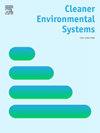Can market-oriented environmental regulation achieve synergistic reduction of atmospheric pollution and carbon emissions? Evidence from China's carbon emissions trading policy
IF 4.9
Q2 ENGINEERING, ENVIRONMENTAL
引用次数: 0
Abstract
Promoting the synergistic reduction of atmospheric pollution and carbon emissions is of great significance for China to achieve its emission reduction commitments. Based on the emission factor method (EFM), the difference-in-difference (DID) model, and the index decomposition, this paper calculates the integrated emission equivalent of atmospheric pollution and carbon emissions, and explores the impact of carbon emissions trading (CET) on the synergistic reduction effects. The results show that CET can significantly promote the synergistic reduction enhancement. After parallel trend test, endogeneity test, and PSM-DID, the conclusion still holds. Heterogeneity analysis reveals that the synergistic effects are more significant in the eastern and western regions of China. Market mechanism tests show that moderately increasing the penalty for default can promote the synergistic effects, while excessive government intervention has an inhibitory effect. Further analysis shows that the synergistic effects mainly come from energy efficiency and economic development effects, while the synergistic effects of pollution control are gradually strengthening. Examining the synergistic reduction through CET aligns with the concept of green development in China and provides evidence for the coordinated governance of multiple pollutants.
以市场为导向的环境监管能否协同减少大气污染和碳排放?来自中国碳排放交易政策的证据
推动大气污染与碳排放协同减排,对中国实现减排承诺具有重要意义。基于排放因子法(EFM)、差分差分(DID)模型和指标分解,计算大气污染与碳排放的综合排放当量,探讨碳排放权交易(CET)对协同减排效应的影响。结果表明,CET能显著促进协同还原增强。经平行趋势检验、内生性检验和PSM-DID检验,结论仍然成立。异质性分析表明,中国东部和西部地区的协同效应更为显著。市场机制检验表明,适度加大违约处罚力度能够促进协同效应,而过度的政府干预则具有抑制效应。进一步分析表明,协同效应主要来自能源效率效应和经济发展效应,而污染治理的协同效应正在逐步增强。通过CET研究协同减排符合中国绿色发展的理念,并为多种污染物的协调治理提供了证据。
本文章由计算机程序翻译,如有差异,请以英文原文为准。
求助全文
约1分钟内获得全文
求助全文
来源期刊

Cleaner Environmental Systems
Environmental Science-Environmental Science (miscellaneous)
CiteScore
7.80
自引率
0.00%
发文量
32
审稿时长
52 days
 求助内容:
求助内容: 应助结果提醒方式:
应助结果提醒方式:


